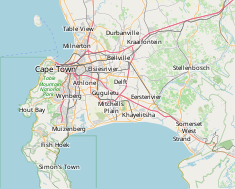Groote Schuur
| Groote Schuur | |
|---|---|

View of the rear of Groote Schuur, c1905.
|
|
| Location | Rondebosch, Cape Town, South Africa. |
| Coordinates | 33°57′49.61″S 18°27′50.40″E / 33.9637806°S 18.4640000°ECoordinates: 33°57′49.61″S 18°27′50.40″E / 33.9637806°S 18.4640000°E |
| Built | 18th century |
| Architect | Sir Herbert Baker |
| Architectural style(s) | Cape Dutch |
Groote Schuur ([ɣroːtə sxyːr], Dutch for "big barn") is an estate in Cape Town, South Africa. In 1657, the estate was a plot of land owned by the Dutch East India Company which later became a farm and farmhouse in private hands. Cecil Rhodes took out a lease on the house in 1891. He later bought it in 1893 for £60 000, and had it converted and refurbished by the architect Sir Herbert Baker. The Cape Dutch building, located in Rondebosch, on the slopes of Devil's Peak, the outlying shoulder of Table Mountain, was originally part of the Dutch East India Company's granary constructed in the seventeenth century.
Little of the original house remained after a fire in 1896. The traditional thatched roof was replaced by sturdier Welsh slates. Rhodes gave no strict instructions as to what he wanted from Baker. Rhodes abhorred any mechanically made items (such as hinges for windows) in the house and set out to remove them and have them replaced with brass and bronze items that would be cast. Baker replaced the front of the house, added a long stoep in the back and constructed a new wing. The wing contained a billiard room and master bedroom above on the second floor that contained a large bay window overlooking Devil's Peak. He also added a grand hall with a massive fireplace.
Sir Herbert Baker also played a significant role in the furnishing of the house. After initially furnishing with modern furniture from London, Rhodes, influenced by Baker, began a shift from the modern to more traditional Cape furniture. This would mark the beginning of Cecil Rhodes’ collection of colonial furnishings.
The gardens of the house were as Rhodes demanded 'masses of colour'. Surrounding the house was a mass of roses, hydrangeas, cannas, bougainvilleas and fuchsias. Farther away from the house on the slopes of Devil's Peak, Rhodes kept antelopes, zebra, eland, wildebeest and ostriches.
...
Wikipedia

